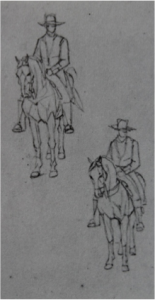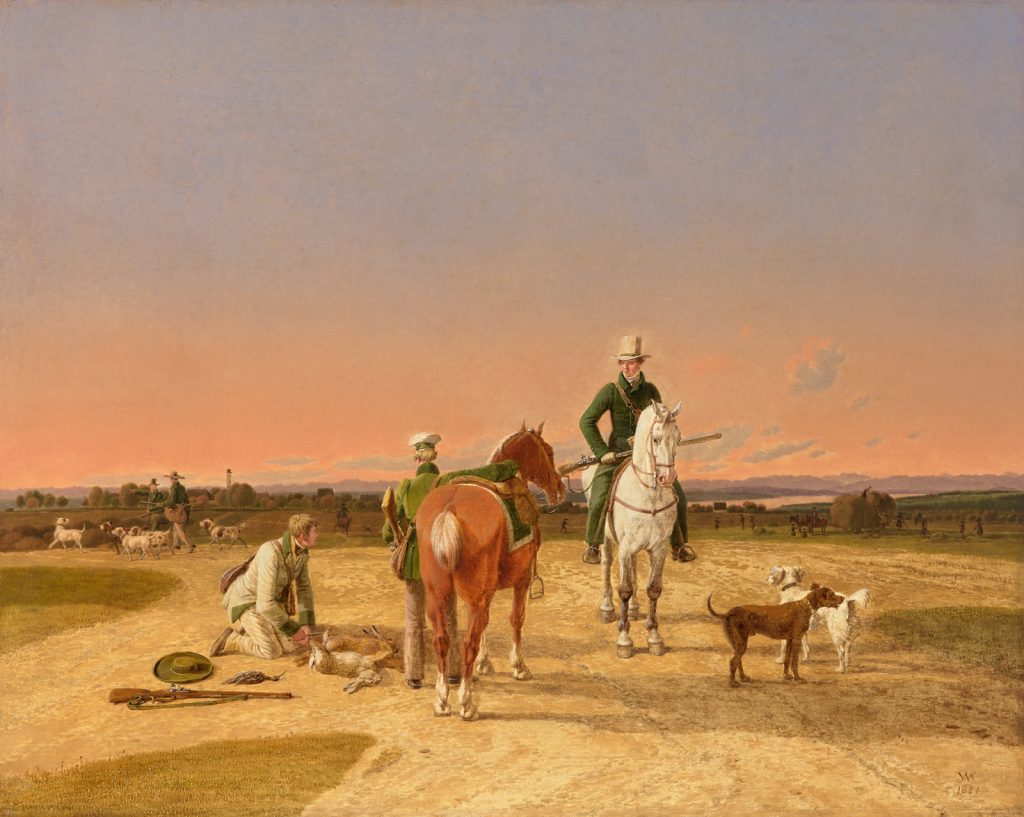Wilhelm von Kobell
(Mannheim 1766 - 1853 Munich)
An Encounter between Huntsmen with a Distant View of Lake Starnberg, 1821
Oil on panel, 32.5 x 40.9 cm
Signed and dated lower right WK (in ligature) 1821
Provenance:
Georg Schäfer private collection, Schweinfurt (inv. 1565)
German private collection
Exhibited:
Von Tischbein bis Spitzweg, Ausstellung von Werken aus bayerischem Privatbesitz. Deutsche und österreichische Malerei von 1780-1850, Kunstverein München, 1960, no. 73, fig. 10
Gedächtnisausstellung zum 200. Geburtstag des Malers Wilhelm von Kobell 1766-1853, Munich, Haus der Kunst, 1966, p. 85, no. 165, repr.
Der frühe Realismus in Deutschland 1800-1850. Gemälde und Zeichnungen aus der Sammlung Georg Schäfer, Schweinfurt, Nuremberg, Germanisches Nationalmuseum, 1967, p. 187, no. 143, repr.
Wilhelm von Kobell, Meister des Aquarells, exhib. cat., Schweinfurt, Museum Georg Schäfer, Munich 2006, p. 98, no. 56
Literature:
Waldemar Lessing, Wilhelm von Kobell, 2nd edition, Munich 1966, repr. in colour
p. 48
Siegfried Wichmann, Wilhelm von Kobell. Monographie und kritisches Werkverzeichnis der Werke, Munich 1970, p. 423, no. 1238
Paul Ernst Rattelmüller, Jagdromantik in der Malerei des 19. Jahrhunderts, Munich 1977, no. 24, repr.
Horst Ludwig, Münchner Maler im 19. Jahrhundert, II, Munich 1982, p. 350
Wilhelm Kobell was born in Mannheim into a family of painters. He succeeded his father Ferdinand Kobell as court painter to Kurfürst Karl Theodor, a position that he continued to hold under the Bavarian kings Maximilian I Joseph and Ludwig I. In the Napoleonic era he worked on a series of extensive battle cycles commissioned by the Bavarian royal family. The cycles show his indebtedness to the battle paintings of seventeenth-century Dutch masters.
Kobell was not to reach artistic and creative maturity until after the Napoleonic era when court commissions were in decline. He found new patrons among the Munich bourgeoisie and the landed gentry, responding to their aesthetic demands with a genre of his own invention, the Begegnungsbild [lit.: encounter picture]. These small, highly sought-after works contributed decisively to the development of early nineteenth-century Biedermeier painting.[1] They are observations of nature in which landscape and figures have equal status and are closely linked. Kobell found a gifted friend in the prominent figure of Johann Georg von Dillis who made him receptive to the effects of natural light and helped him to discover its potential for greater chromatic range and richness. Kobell’s Begegnungsbilder depict actual Bavarian landscapes experienced in natural conditions. The uniforms and costumes of his figures mirror the social context of his patrons. In the present painting the figures are seen from slightly below and are not set against the landscape but seem to rise up against the intense metallic blue of the summer sky, acquiring something of a static monumentality.
A striking feature of this painting is Kobell’s handling of summer light which illuminates the landscape with the intense glow of sunset, casting long shadows. A tall expanse of sky occupies more than half of the image. He has chosen a viewpoint on the morainal ridge above the village of Leutstetten. The eye is led away from the church of St. Alto and across a stretch of moorland towards Lake Starnberg. The massifs of the Wetterstein and Karwendel dominate the horizon. An encounter between two huntsmen depicted on a wide path occupies the foreground of the painting. The more elegant of the two, a rider most probably on his way to the hunt, faces the viewer. He is mounted on a grey thoroughbred. An officer in uniform, his back to the viewer, stands beside his chestnut while his assistant lays out the contents of his bag. The use of counterpose and contrast in the positions and colours of the horses is echoed in the handling of the two hunting dogs at the right.

Fig. 1 Wilhelm von Kobell, Two Sketches of a Rider, c.1820, pencil on paper, 83 x 208 mm, private collection (Wichmann 1231)
A sheet depicting Two Sketches of a Rider (Fig. 1) and a watercolour dated 1820 and titled At the End of the Hunt, Lake Ammersee (Wichmann 1225) recall the motif of the mounted figure in the foreground of the present painting.
Kobell [2] began his artistic training under his father, the landscapist Ferdinand Kobell. He went on to study at the Mannheim Academy. In 1792 he was appointed court painter to Kurfürst Carl Theodor at his seat in the Munich Residenz. With the exception of trips to Vienna in 1809, Paris in 1810 and Rome in 1818 Kobell remained in Munich almost uninterruptedly until his death in 1855. After his move to Munich the influence of Dutch seventeenth-century painting gave way to an increasingly independent style of his own. The works he produced after 1808 for Ludwig I of Bavaria were predominantly battle scenes. Although he ranks alongside Albrecht Adam and Peter von Hess as one of the leading battle painters of the Napoleonic era his Begegnungsbilder were undeniably his greatest contribution to the development of early nineteenth-century painting.
Kobell succeeded Dillis as professor of landscape painting at the Munich Academy in 1814. However, a burgeoning interest in history painting coupled with the nomination of Peter von Cornelius as academy director led to a general spurning of landscape as a discipline. In 1826 the landscape class was discontinued.
[1] For a discussion of Kobell’s Begegnungsbilder see Wichmann, op. cit., pp. 72-4.
[2] For information see Siegfried Wichmann, Wilhelm von Kobell. Monographie und kritisches Werkverzeichnis der Werke, Munich 1970; Horst Ludwig, Münchner Maler im 19. Jahrhundert, II, Munich 1982, p. 350 et al.

